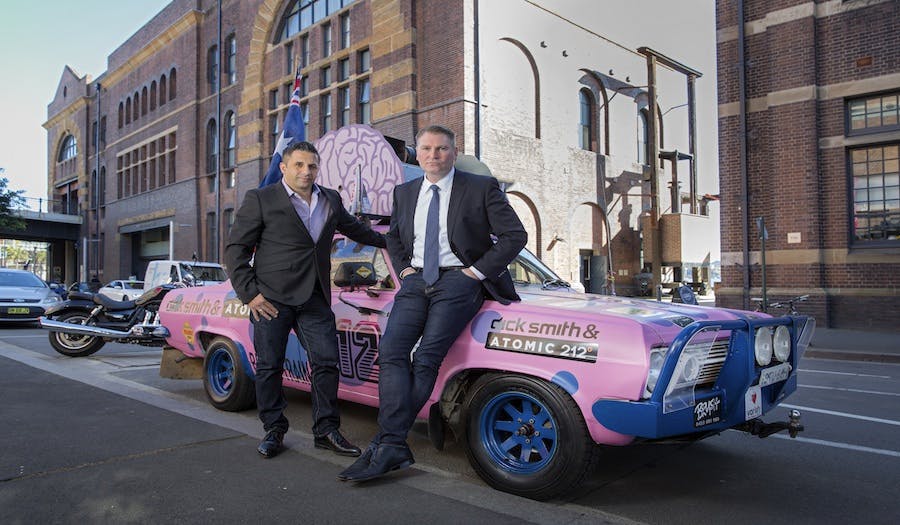There is often an incorrect assumption among vendors and marketing agencies that you need to be a huge operation to catch the big fish clients. While a one-man business is probably not going to be able to service a $50 million media account, that doesn’t mean you have to be the biggest agency in town to service the largest clients.
When my business Atomic 212 opened its doors as an independent full service media agency, we could boast major clients like Dick Smith Electronics and AMP. This was despite the fact that at the time, we were only a mid-sized company. The clients were more interested in our ideas and creativity than our head count. Of course, we needed the operational infrastructure to back this up, but that didn’t necessarily mean we had to be a cumbersome goliath to service these major accounts.
Take Dick Smith Electronics, for instance – we were recently named Partner of the Year by the company. What’s more, we are currently joint sponsors of the Variety Bash, with our car The Brain Train – a 1966 Holden HR that looks like a giant brain – bashing through the outback, flying the flag for agency and client alike. Above all, the Variety Bash is an opportunity for our organisations to raise money for sick or disadvantaged children, but it is also an opportunity to solidify our partnership.
As a mid-sized operator, when it comes to landing the big fish, and more importantly maintaining that relationship, there are a couple of key pointers I like to keep in mind.
1. Be a partner, not a benchwarmer
The risk for many smaller businesses is that they get caught in what I like to call the ‘celebrity syndrome’. It’s almost as if they are so thankful to have won the business of a blue chip ‘celebrity’ brand that they forget why they were commissioned in the first place. You have to be confident with your offering and it’s important to avoid being subservient, otherwise the client won’t respect you, and you’ll be back in pitch mode before too long. I see this type of attitude all the time across many media and marketing agencies, both big and small. In a post-GFC climate, many agencies become so happy to win the business of a big name brand, that they are willing to drop their prices and compress margins, even at the risk of damaging their own business. This is short sighted. I have a strong professional relationship with Dick Smith’s CEO Nick Abboud, and this is largely due to the collaborative approach both businesses have adopted. We are both equal sponsors for the Variety Bash – a true partnership.
2. Come with solutions, not problems
If you want to chase the big fish, you need to be sure you can bring the goods. You can’t half-ass anything and you need to know your client’s business, even better than they do. I am truly shocked when I hear stories about vendors who don’t do their homework. The key is curiosity. If your client asks you a question, you need to have an answer. If they have a problem, you need the solution. This doesn’t mean you always have to be right, but you do need to have a point of view, and you need to be constantly looking for the right approach. For example, earlier this year we did a piece of research with Dick Smith relating to TV ad placements. We went into the study expecting certain results, but the outcome was not what we anticipated. So we changed our television strategy, and adapted media spend accordingly. The results have been phenomenal – almost double the recall among relevant audiences.
3. Every client is important
Just because you have nabbed a major brand name partner, don’t forget about the rest of your clients. This is another slip up I see all the time. Obviously a client with a massive budget will take up a disproportionate amount of time within the agency – of course they should, they’re paying the most for your services. But every client is important, big or small. In fact, the above pointers can really be applied to all business partners, whether or not they’re a big fish. Some of the best work we’ve done as an agency has been for our smallest clients. A business which respects the relationships it has with all of its clients has a better internal culture, because it does not become subsumed by a single client.
These are obviously broad stroke approaches. But as my agency continues to grow, they are lessons I like to keep front of mind. Any business can win the big fish clients at first instance. If you can keep them happy and maintain a strong relationship, that’s the true sign of success.
About the author:
This article was written by Jason Dooris, the CEO and founder of Atomic 212, Australia’s fastest growing media and marketing agency on the BRW 2014 list. Over the past 20 years, Jason has held a variety of senior local and global industry positions including CEO MediaCom UK, deputy CEO MediaCom Europe, GM Saatchi & Saatchi NZ, GM Ogilvy & Mather Australia, GM Dentsu Aegis Australia and consulting practice director, Deloitte Asia. His vertical experience covers most categories with a particular focus on retail, automotive and FMCG.

